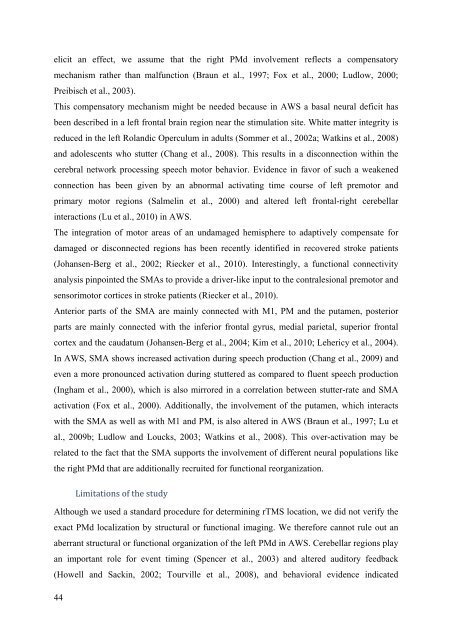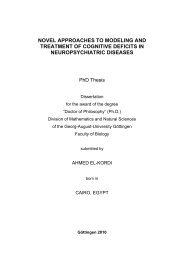Cortical and subcortical mechanisms in persistent stuttering ...
Cortical and subcortical mechanisms in persistent stuttering ...
Cortical and subcortical mechanisms in persistent stuttering ...
Create successful ePaper yourself
Turn your PDF publications into a flip-book with our unique Google optimized e-Paper software.
elicit an effect, we assume that the right PMd <strong>in</strong>volvement reflects a compensatory<br />
mechanism rather than malfunction (Braun et al., 1997; Fox et al., 2000; Ludlow, 2000;<br />
Preibisch et al., 2003).<br />
This compensatory mechanism might be needed because <strong>in</strong> AWS a basal neural deficit has<br />
been described <strong>in</strong> a left frontal bra<strong>in</strong> region near the stimulation site. White matter <strong>in</strong>tegrity is<br />
reduced <strong>in</strong> the left Rol<strong>and</strong>ic Operculum <strong>in</strong> adults (Sommer et al., 2002a; Watk<strong>in</strong>s et al., 2008)<br />
<strong>and</strong> adolescents who stutter (Chang et al., 2008). This results <strong>in</strong> a disconnection with<strong>in</strong> the<br />
cerebral network process<strong>in</strong>g speech motor behavior. Evidence <strong>in</strong> favor of such a weakened<br />
connection has been given by an abnormal activat<strong>in</strong>g time course of left premotor <strong>and</strong><br />
primary motor regions (Salmel<strong>in</strong> et al., 2000) <strong>and</strong> altered left frontal-right cerebellar<br />
<strong>in</strong>teractions (Lu et al., 2010) <strong>in</strong> AWS.<br />
The <strong>in</strong>tegration of motor areas of an undamaged hemisphere to adaptively compensate for<br />
damaged or disconnected regions has been recently identified <strong>in</strong> recovered stroke patients<br />
(Johansen-Berg et al., 2002; Riecker et al., 2010). Interest<strong>in</strong>gly, a functional connectivity<br />
analysis p<strong>in</strong>po<strong>in</strong>ted the SMAs to provide a driver-like <strong>in</strong>put to the contralesional premotor <strong>and</strong><br />
sensorimotor cortices <strong>in</strong> stroke patients (Riecker et al., 2010).<br />
Anterior parts of the SMA are ma<strong>in</strong>ly connected with M1, PM <strong>and</strong> the putamen, posterior<br />
parts are ma<strong>in</strong>ly connected with the <strong>in</strong>ferior frontal gyrus, medial parietal, superior frontal<br />
cortex <strong>and</strong> the caudatum (Johansen-Berg et al., 2004; Kim et al., 2010; Lehericy et al., 2004).<br />
In AWS, SMA shows <strong>in</strong>creased activation dur<strong>in</strong>g speech production (Chang et al., 2009) <strong>and</strong><br />
even a more pronounced activation dur<strong>in</strong>g stuttered as compared to fluent speech production<br />
(Ingham et al., 2000), which is also mirrored <strong>in</strong> a correlation between stutter-rate <strong>and</strong> SMA<br />
activation (Fox et al., 2000). Additionally, the <strong>in</strong>volvement of the putamen, which <strong>in</strong>teracts<br />
with the SMA as well as with M1 <strong>and</strong> PM, is also altered <strong>in</strong> AWS (Braun et al., 1997; Lu et<br />
al., 2009b; Ludlow <strong>and</strong> Loucks, 2003; Watk<strong>in</strong>s et al., 2008). This over-activation may be<br />
related to the fact that the SMA supports the <strong>in</strong>volvement of different neural populations like<br />
the right PMd that are additionally<br />
recruited for functional reorganization.<br />
44<br />
Limitations of the study<br />
Although we used a st<strong>and</strong>ard procedure for determ<strong>in</strong><strong>in</strong>g rTMS location, we did not verify the<br />
exact PMd localization by structural or functional imag<strong>in</strong>g. We therefore cannot rule out an<br />
aberrant structural or functional organization of the left PMd <strong>in</strong> AWS. Cerebellar regions play<br />
an important role for event tim<strong>in</strong>g (Spencer et al., 2003) <strong>and</strong> altered auditory feedback<br />
(Howell <strong>and</strong> Sack<strong>in</strong>, 2002; Tourville et al., 2008), <strong>and</strong> behavioral evidence <strong>in</strong>dicated



